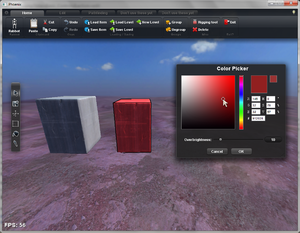Editor Interface
![]() Work in Progress: Comments & Edits Welcome
Work in Progress: Comments & Edits Welcome
This page is in dire need of an update!
Contents
Introduction
This page details all the interface elements found in the Overgrowth level editor. If you're looking for a control/hotkey reference, go to the Control Reference. Press 9 when playing to bring up the editor interface.
Ribbon User Interface
The horizontal bar across the top of the window is called the ribbon. All editor functions can be found here with a few exceptions as some functions can only be reached via hotkeys for now.
Item Browser
The item browser is used to browse for items that can be spawned in the levels. It is brought up by pressing the Load Item button under the Home tab. To spawn an item, click it and then click in the world to create the item on that location.
This list does not necessarily contain all the objects that can be spawned as all objects need to be manually added to the list. A file browser can be brought up by pressing the folder icon just under the tabs at the top. That file browser can be used to try loading any xml file, which is useful if you're trying to load a custom object that has not been added to the item browser for instance. The types of items that can be spawned are objects (static models), characters, weapons, hotspots, decals and spawn points.
Along the top of the window there are tabs for different categories of items. In the bottom right there is a slider to change the size of the thumbnail images as well as a grip that can be clicked and dragged to resize the window. A search field that searches in the currently open tab is located under the tabs to the right.
Hovering your mouse cursor over a thumbnail image causes a heart icon to appear on the thumbnail. If that heart icon is pressed the object is added as a favorite. To sort out any object that is not a favorite from the view, press the heart button right under the tabs at the top of the window. The favorites do not persist between closing and opening the item browser.
Other Tools
Color Picker
The Color Picker is used to change the base colors of selected objects using a color slider+gradient box combo. The color picker is opened by pressing CTRL+P (For Mac users: Command+P) while in edit mode. You are still free to manipulate/select/deselect objects in the world you're editing while the color picker is opened. The color picker consists of a color-gradient box, a rainbow slider, two boxes of different sizes showing the basic chosen color, RGB values, a hex value, and an OverBrightness slider and text box. The OverBrightness is essentially the overall brightness of the object. Using this basic tool, one can alter the colors of objects to something to more of their liking.
Character spawns can also be affected by the CTRL+P shortcut. If a character spawner is selected and CTRL+P is pressed, the spawner will alternate between a Rabbot and a Computer controlled spawn point. Using this technique, one can make computer controlled Rabbot characters for the player to fight. Though it is not recommended, as it appears that having a computer controlled rabbot character is severely laggy.
Saving Combined Object As A Separate File
Once you have created something you wish to use elsewhere, press Ctrl+Shift+S (On Windows) or Command+Shift+S (on Mac) to open an object saving dialog. This way, you can save buildings, trees or obstacle courses made from many parts as a single XML object, ready to be imported back to Overgrowth.
Summary
So, in total we went over the general interface of Overgrowth, and went in depth on the functions of the Palette. In truth, once you get a hang of using the tools it gets easier from there. Even when editing Decals or Hotspots, it's all just a process of getting used to the way the editor works. Also, feel free to use any of the tutorial images on the right side as quick reference guides incase you forget anything. Also, the two links below are incredibly useful, I'd highly recommend them.
Thanks to Phillip and the whole Wolfire team for any information I used from them.
